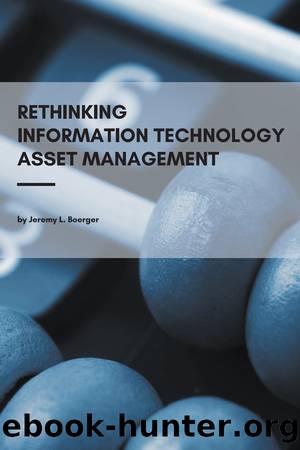Rethinking Information Technology Asset Management by Jeremy L. Boerger

Author:Jeremy L. Boerger
Language: eng
Format: epub
Publisher: Business Expert Press
Published: 2021-03-19T00:00:00+00:00
Identifying Data Customers and Critical Fields
There are only two questions driving our activity in this phase:
1. Who is asking for ITAM information?
2. What ITAM information are they asking for?
Earlier in this book, we identified IT Security as one data customer. ITSec is keenly interested in how well their vulnerability scanning tools are penetrating the environment. ITAM is in the best position to report on that data since ITAM needs to know its SSoT is penetrating the same environment. IT Service Management (ITSM) is another data customer discussed earlier in this book, since ITSM requires verified user and Asset Lifecycle data to efficiently deliver their services. IT Finance (ITFin) is a third, as they will be interested in the relationship between consumed and unconsumed assets in their quest to maximize ROI and minimize TCO.
These departments are among the easiest to communicate and collaborate with because the discovery process often involves the ITAM team asking these very same departments questions and probing them for answers. By relaying back verifiably accurate data that helps them, a mutually beneficial relationship can flourish.
We need to examine what types of data customers we are dealing with because their needs will determine our critical fields.
ITSec, ITSM and ITFin are examples of internal data customers we need to consider.
Software publishers and the license auditors they employ are external data customers. Publishers and auditors are outside of your organization and their interests are separate from your organizationâs interests. Maybe parallel, like a good service provider should be, but letâs not kid ourselves.5
Because publishers and auditors are outside of your organization, you cannot just call them up and ask them about their audit details to find out what data they need from you. (As any veteran ITAM expert will tell you, that will instantly trigger an audit!) The good news is, these data customers have already told you exactly what details they will expect from you should an audit occur (and one will eventually). Those details are buried within the master agreements (MAs), end-user license agreements (EULAs), volume license agreements (VLAs), and other underpinning documentation.
MAs, EULAs, and VLAs are legally binding contracts describing the relationship between the software publisher and the software user. Somewhere in them, the ITAM team will find language describing the nature of the use rights granted to your organization by the publisher. Two of the most common use licenses (see Figure 5.1 and Figure 5.2 for example text) are user-based licensing and computer-based licensing or device licensing.6
Download
This site does not store any files on its server. We only index and link to content provided by other sites. Please contact the content providers to delete copyright contents if any and email us, we'll remove relevant links or contents immediately.
Time Management Made Easy: How to Cultivate New Habits, Improve Productivity and Get Things Done by Joshua Strachan(2388)
The 7 Habits of Highly Effective People by Stephen R. Covey & Sean Covey(2196)
The Concise Laws of Human Nature by Robert Greene(1800)
Doesn't Hurt to Ask by Trey Gowdy(1601)
Primal Leadership by Daniel Goleman(1215)
Hook Point: How to Stand Out in a 3-Second World by Brendan Kane(1162)
HBR's 10 Must Reads 2021 by unknow(1071)
Don't Sweat the Small Stuff...and It's All Small Stuff by Richard Carlson(1067)
Amazon Unbound by Brad Stone(1010)
100 Things Successful People Do by Nigel Cumberland(996)
HBR's 10 Must Reads 2021 by Harvard Business Review(980)
The Job Closer by Steve Dalton(968)
Master of One by Jordan Raynor(967)
Lives of the Stoics by Ryan Holiday & Stephen Hanselman(931)
Declutter Your Mind: A step by step guide to learn to control your thoughts, stop worrying, relieve anxiety and eliminate panic attacks and negative thinking by Mia Chandler(917)
The Power of 100! by Shaun King(904)
Conflicted by Ian Leslie(833)
Coders at Work: Reflections on the craft of programming by Peter Seibel(817)
The Book of Hope by Jane Goodall(803)
